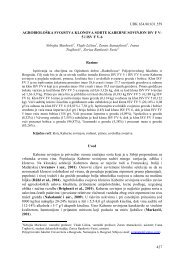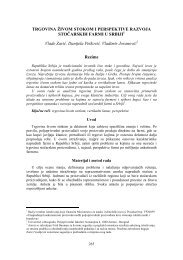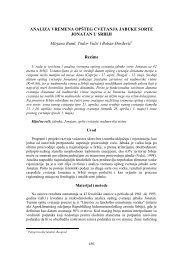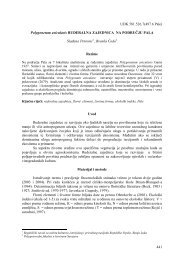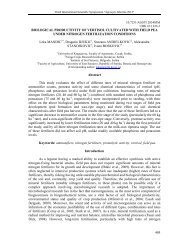178 POMOLOGICAL CHARACTERISTICS OF SOME RASPBERRY ...
178 POMOLOGICAL CHARACTERISTICS OF SOME RASPBERRY ...
178 POMOLOGICAL CHARACTERISTICS OF SOME RASPBERRY ...
Create successful ePaper yourself
Turn your PDF publications into a flip-book with our unique Google optimized e-Paper software.
Third International Scientific Symposium "Agrosym Jahorina 2012"<br />
of winter pruning was done with the type Heritage, where the complete upper part of plant is<br />
removed, with goal to obtain fruits only on primocanes of fruits. In that way significantly<br />
longer period of ripening (60 – 80 days) can be provided, what would later reflect on<br />
specificity of this system on methods applied during the research.<br />
As a material in this work we used raspberry types Willamette, Meeker and Heritage.<br />
Willamette is the most present in raspberry production in Bosnia and Herzegovina. Type<br />
Meeker is marked as perspective and highly productive one, with a trend of increasing<br />
surfaces, and the type Heritage is newly introduced primocane fruiting type which<br />
development and expansion are still negligible. Researches were done in 2011, and sampling<br />
of fruit was done in accordance to the principle of “random selection“ in a production nursery.<br />
From pomological characteristics of examined types, the following ones were analysed: fruit<br />
weight (g); fruit length (mm); fruit width (mm); thickness of fruit (mm), number and mass of<br />
seeds; chemical fruit composition: total content of soluble solids (%); total sugar content (%);<br />
sucrose content (%); total acid content (%); pH value. Among biological features, fruitiness<br />
and dynamics of type ripening were also analysed.<br />
Fruit weight was determined on the sample of 30 fruits of each above mentioned types,<br />
by measuring on analytical scales brand Chyo type „Petit balance“, with the exactness of<br />
1/100 g. Fruit length, width and thickness were measured by movable measure, brand „GOST<br />
166-80“ with the exactness of 0.1 mm and measurable extent 0-125 mm. Number and mass of<br />
seeds were determined on the sample of 10 fruits of each type, by measuring on analytic scale,<br />
brand Chyo type „Petit balance“, with the exactness of 1/100 g.<br />
Chemical fruit composition: Content of soluble solids was determined refractmetrically.<br />
Content of total acid was measured by titration with 0.1 N NaOH solution, sugar<br />
content (total and inverted) was done volumetrically according to Luff-Schoorl method, and<br />
sucrose content by calculating. The pH value was determined by pH-meter.<br />
Yield potential of examined types was registered by determination of kg/ha and<br />
kg/shoot for each type.<br />
The results for fruit weight are processed by the statistical method of the analyses of<br />
variance for monofactorial experiment. The significance of differences between mean values<br />
is determined by Duncan’s multiple range test at P=0,05.<br />
Variety<br />
Results and discussion<br />
Table 1. Physical fruit characteristics of examined raspberry varieties<br />
Fruit Fruit length Fruit width Fruit thickness Number<br />
weight (g) (mm) (mm) (mm) of seeds<br />
Mass of<br />
seeds/<br />
Willamette 3.51 b 21.33±0.29 20.85±0.33 6.88±0.14 78.6 0.21<br />
Meeker 4.00 a 22.38±0.26 21.29±0.17 6.93±0.093 88.8 0.26<br />
Heritage 3.49 b 21.54±0.31 20.88±0.27 6.85±0.093 98.2 0.24<br />
Means followed by the same letter do not differ significantly according to Duncan’s multiple range test<br />
at P=0,05<br />
Good fruit quality is the basic aim in raspberry production. There are different fruit<br />
colours (red, black, purple and yellow) depending on type. The fruit weight also varies<br />
depending on raspberry type as well as environmental conditions. Thus, the weight of wild<br />
raspberry varies from 1.1 – 1.6 g (Petrovic and Milosevic, 2002), while the fruit weight of<br />
cultivated raspberries range from 3 g to 6 g (Misic and Nikolic, 2003). The results of fruit<br />
weight and dimensions are given in table 1. Minor differences can be observed in fruit<br />
179





